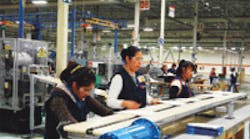Avery Dennison Office Products de Mexico S. de R.L. de C.V.: IW Best Plants Profile 2010
Avery Dennison Office Products de Mexico S. de R.L. de C.V., Tijuana, Baja California, Mexico
Employees: 797, nonunion
Total Square Footage: 523,845
Primary Product/Market: office products
Start-Up Date: 1999
Achievements: Over five years, reclaimed 310,000 square feet of plant-floor space through lean initiatives; 98% first-pass yield; nearly $6 million in documented improvement projects in 2009
There's probably enough open space at the Avery Dennison Office Products de Mexico plant in Tijuana to play a football game. Upon entering the plant, actual manufacturing activity seems so distant a pair of binoculars might be necessary. But plant leaders say the empty area is a sign of progress.
That's because through value-stream mapping and lean initiatives, the organization was able to free 310,000 square feet of space in the 524,000-square-foot plant over a six-year period. By 2011 the effort is expected to bring the plant's share of Avery Dennison's North American office products production to 66% from just 15% in 2004.
The plant received a boost in 2008 when the company's Fontana, Calif., distribution center closed and relocated to the Tijuana operations. The plant consolidated what occupied 400,000 square feet in Fontana into 230,000 square feet, says Key Fujimura, the plant's continuous improvement leader. Then, on Oct. 20, 2010, the plant received more good news when Avery Dennison announced it would move its Ciudad Juarez printed media and dividers operations to Tijuana. The transition is expected to be completed in the fall.
See the other winners of IW's 2010 Best Plants award and find out how they made the top ten.
The plant first began releasing space in 2004. At the time, the facility was cluttered with machines, inventory pallets and material, says plant manager Arnoldo Pena. Plant leaders began opening space by eliminating inefficient older equipment and improving existing machines, moving to continuous-flow production from batch processing and reconfiguring lines into U-shaped cells. In 2009, the area where the plant produces three-ringed binders cut its footprint in half with a reconfigured cell design, Pena says.
All plant personnel are expected to keep a close eye on performance and improvement opportunities through various group activities. One of the more significant events comes in September when the school year begins and the company's peak season ends.
The plant takes part in five-day, high-level value-stream mapping events called SWOT, short for strengths, weaknesses, opportunities and threats. The events comprise cross-functional work teams from different departments that create the operation's road map for future success, or "shikumi." The shikumis are then used to develop an A3 plan, or business strategy for the following year. "Everybody has input into what went wrong and what went right," says Hector Marquez, operations manager. "So this is a process that's been dynamic and adjusts to current needs."
On the plant floor, one of the more innovative employee-generated ideas came from line worker Azucena Robles, who operates the machines that apply labels to the company's famous Glue Stic brand. Previously, when the feeder ran out of labels, Robles would have to stop the machine for five minutes as many as 30 times per day to refill the labels to prevent blank Glue Stic rolls from moving down the line. Robles suggested that the plant install a machine that shoots compressed air to push the blank rolls off the line into a box, saving the line from frequent delays.
Such a high level of employee involvement should come in handy next fall when product complexity is expected to double and the number of stock-keeping units will jump to 4,000 from 1,800.
Avery Dennison's Tijuana Plant Maps its Future
Office-supplies operations creates roadmap for success.
Avery Dennison Office Products de Mexico in Tijuana is literally creating a roadmap to success. The mapping and planning process is central to the plant's extensive expansion and continuous-improvement efforts.
The maker of popular office and school products, including Marks-A-Lot markers and Hi-Liters, has freed 310,000 square feet of space over six years in the 524,000-square-foot plant through its planning processes. The ability to open substantial space helped the plant gain new business, including the planned consolidation of the company's Ciudad Juarez facility into Tijuana.
Each year in the final fiscal quarter, the plant begins a process called SWOT, short for strengths, weaknesses, opportunities and threats. This is a series of events that takes place over a five-day period and involves cross-functional teams from each business unit. The purpose of the event is to share ideas at different levels on various issues, Avery Dennison states in its Best Plants application.
The ideas generated in these meetings are then used as input for its "shikumi" events and the plant's A3 strategy. Shikumi events are high-level value-stream mapping meetings that cover the entire supply chain, including cycles such as customer work orders, suppliers, new product introduction and manufacturing and support systems, explain plant leaders.
The shikumis occur in September after back-to-school rush has ended, says Key Fujimura, the plant's continuous improvement leader. Timing the shikumis after the peak season gives the plant leaders an opportunity to take a step back and examine any critical issues that may have arose during the rush, says Fujimura.
The map includes a before state with opportunities for improvement and then a future state of where the plant wants to be in the coming year, including quality, lead-time and waste improvements. The maps are prominently displayed along a wall near the plant entrance.
The plant then creates its A3 strategy, which includes inputs from the shikumi and SWOT events and the division and corporate goals. The A3 strategy serves as an outline of major initiatives the plant will adopt in the following year as part of a guiding document called Objectives, Goals, Strategies and Metrics, or OGSM.
At Avery Dennison's Tijuana plant, the continuous-improvement process is truly "continuous." Plant leaders schedule regular meetings to review key-performance metrics and involve all layers of the shop floor in the process.
"Once we have this document, we look to see how are we aligning our people to follow what we said going to do," says Alma Dominguez, the plant's Enterprise Lean Sigma and quality assurance manager.
Employees from all levels have input into examining the current state and establishing future goals, says Marquez, operations manager.
"This has evolved throughout years," he says. "It started at a high level with leaders. Now, over the last two or three years, everybody has input into what went wrong and what went right. So this is a process that's been dynamic that adjusts to current needs."




